Meta title belongs to the meta tags and is one of the basic things you should set when running a website. It has a big impact on whether a user will come to your site from the organic search results page (i.e. from Google). Unlike the meta description, which is also a meta tag, the meta title is a ranking factor – and therefore affects your site’s position in Google. That’s why I invite you to learn about the meta title tag from the inside out, so that it works best for your site’s position in search results.
.
Meta tags are pointers to the content on a page that help crawlers and search engines understand what a subpage is about. We place meta tags only in the code of the page, usually in the head section. Therefore, they are only visible to search engines, browsers and people who know how to find them (just view the page source and go to the head section).
There are quite a few types of meta tags, so I will only list the ones that are most important from an SEO point of view.
- Meta title – this is what the article is about, so a detailed description will be below.
- Meta description – page description – this is a short text to introduce the user to what is on the website. It should include a keyword that is bolded in the search results, a CTA – that is, a reference to the action the user should perform, and something that makes your company stand out – such as 24-hour delivery.
.
Noteworthy, the process of creating a meta description can be automated, if only through SEO plugins in WordPress. This is especially useful for ecommerce. You also need to take into account that Google often adjusts the meta descriptions on a page on its own – when it decides that some part of the text contained on the page more closely matches the intent of the query. The exceptions here are branded queries and long tail phrases. In terms of SEO impact, the meta description is not a ranking factor, but it can affect the CTR (click-to-target ratio) from a search results page.
- Meta robots – using this tag, we have several options for communicating what indexing robots can and cannot do on our site. The most important directives are:
.
> index – means that we want the page to be displayed in the search results. Popular CMSs add it automatically. The absence of this tag for a search engine will mean the same thing as its presence.
> noindex – used to tell the search engine that we do not want the page to be indexed.
You can also use the robots.txt file to manage sub-page indexing. However, it is not used directly for de-indexing. It blocks the robot’s access to the subpage, but does not pass on the noindex information. A robot that does not access the indicated subpage will, of course, not be able to index it. Therefore, you need to remember to assign a disallow directive to pages with noindex in the robots.txt file. If you want to learn more about this topic, read our guide on robots.txt file.
- noflollow – conveys the information for search engine robots not to follow outgoing links from the subpage. With this solution, we will avoid the transfer of power from our site to other subpages.
- follow – here the opposite situation compared to nofollow. We show the robots that we want to transfer power and direct the indexing robot to the pages indicated from the links.
.
Below is a manual for meta robots prepared by Gregory Rifleman from the course papaseo.com.
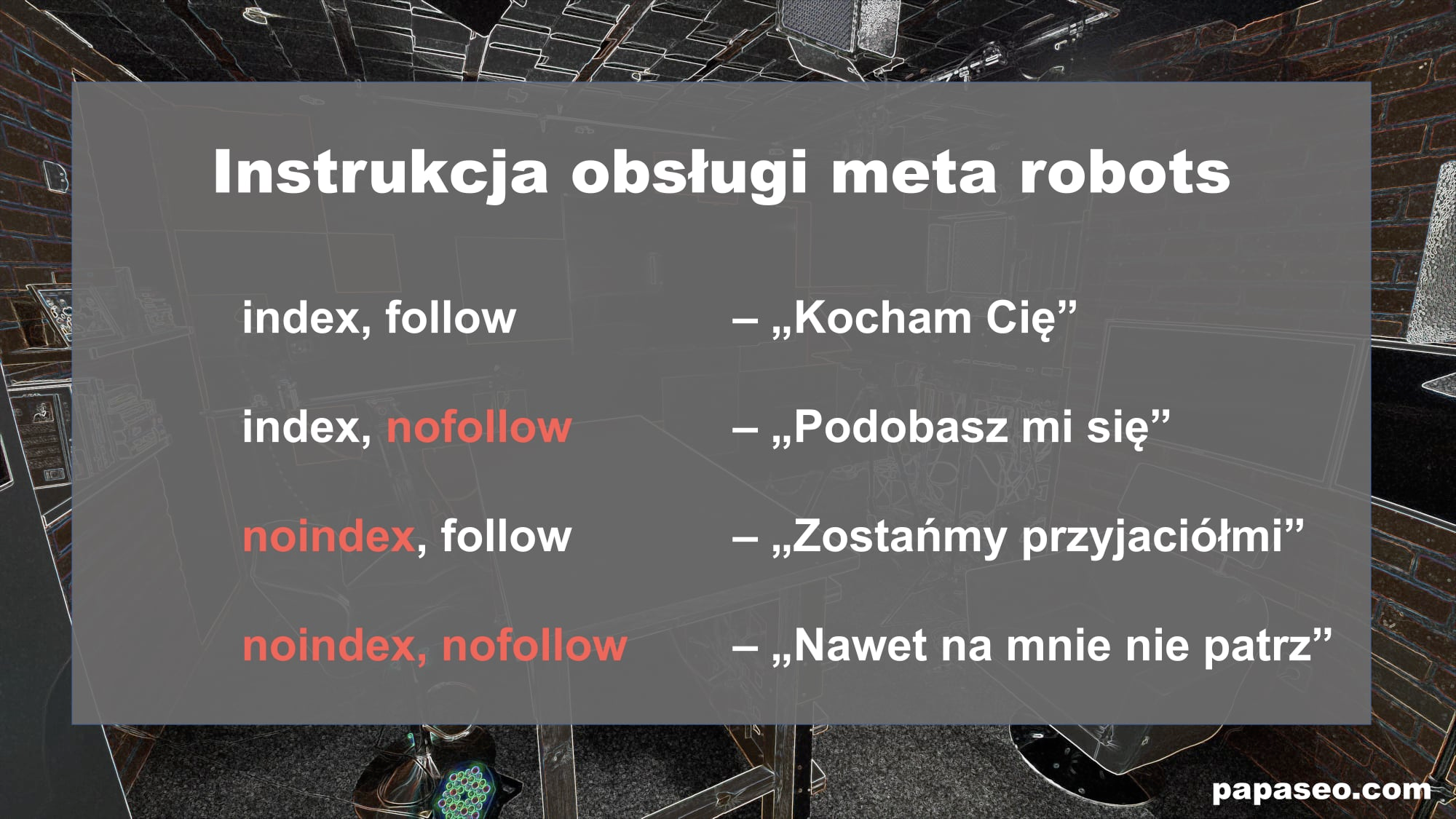
- Meta keywords – a tag that has not been considered a ranking factor for a very long time. Completing it is a waste of time, so I provide it as a warning.
What is a meta title, what should it look like and what requirements should it meet
.
So what is a meta title? It is a text that allows us to determine what should be displayed on the Google search page. Its content is very important, and for this reason it should not be missing from any sub-page of the website. Title is not used only in SERPs (search results), but also in the browser tab.
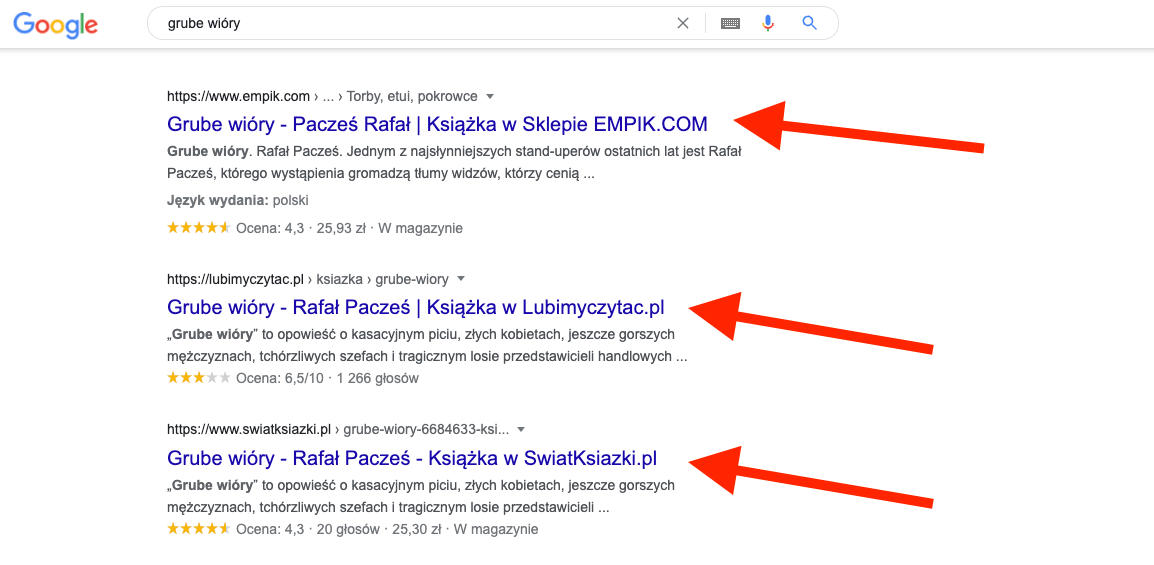
 .
.
Its HTML code should look as follows:
<title>The title you want to give to the page</title>
.
The title meta is also important in terms of CTR. It tells the user what is on the page, so it should be written with the user’s intent in mind (suggest that the user will find the answer to their query on the page).
What requirements should the meta title tag meet?
.
The meta title tag should begin with a keyword. Such a procedure helps to draw the user’s attention. Some experts report that if the phrase that an Internet user types into Google is at the top of the search results, there is a greater likelihood that he will click on our link.
A common mistake is to intentionally put the same text in the H1 header and meta title. Both of these elements have completely different roles in SEO. H1 is an editorial title, so it can be longer. Keep in mind that one and the other should contain the most important keyword for which the subpage should be positioned.
An element that may or may not include a meta title is the CTA – or call to action.
The Meta title should meet certain guidelines as to length. This is another reason why the H1 header and meta title should be different. We have limited space on the search results page – which is not the case for the header on our page (H1).
The recommended length of a page’s meta title tag is 600px.
As you can see, this value is expressed in pixels. Why? Because each letter has a specific width. Therefore, specifying character ranges can lead to a situation where the page title is too long.
What happens if the title is longer than the specified values? Simply, the last word in the meta title will be truncated and replaced with three dots with a width of 20px (how to disreputably use these three dots and 20px for better positions will be discussed in a moment)..
This is not good news, as a dropped title can result in a decrease in the website’s click-through rate. It is important to keep an eye on such a situation. I recommend a tool to check the length of meta title and description tags: https://totheweb.com/learning_center/tool-test-google-title-meta-description-lengths/
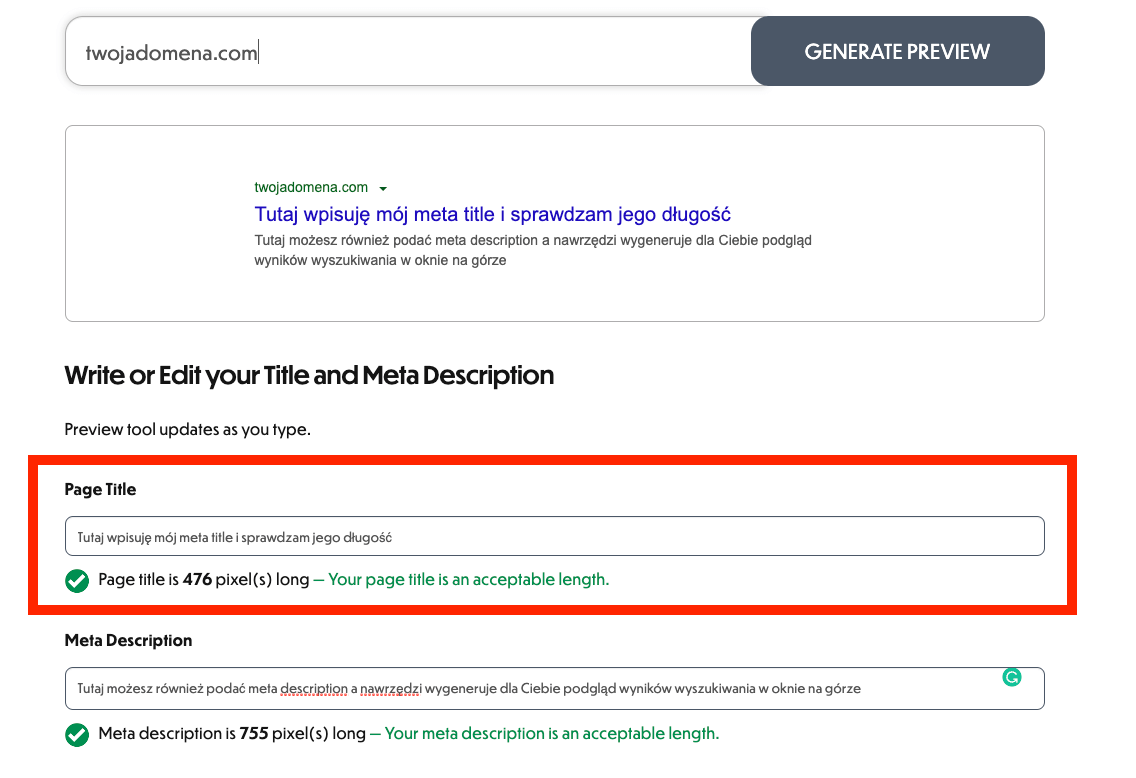 .
.
Update to Google’s page title generation algorithm
.
In August 2021, Google introduced an update regarding the display of page titles in SERPs. From now on, for some sub-page addresses, Google will prepare the meta title tag itself and display it on the search results page.
On what basis does it determine the new page title? Googlebot checks the H1 header, anchor links leading to the page, and the content that appears on it. Clearly, such a change resulted in a drop in CTR for sites to which Google changed the meta title – even though their position in search results did not change.
Why did this happen?
.
Google has always been trying to improve its algorithms in such a way that search users get the best possible results. The same is true this time, too.
Google’s official stance on the matter is that at this point they themselves are able to generate titles better suited to the query than some site owners do.
The conclusion that emerges is quite simple – the quality of meta titles used on websites was simply too poor.
Some consolation in this situation is that Google still uses meta title tags more than 80% of the time to generate page titles in search results.
What to do if Google has changed your meta title?
.
First of all, you need to check what pages are showing up in search results with a different title than the one set on the page.
I have a simple and free way for you to approach this – install the Keyword Surfer plug-in for your Chrome browser. After its installation, you will see “Title changed” on the results page next to the changed meta title.
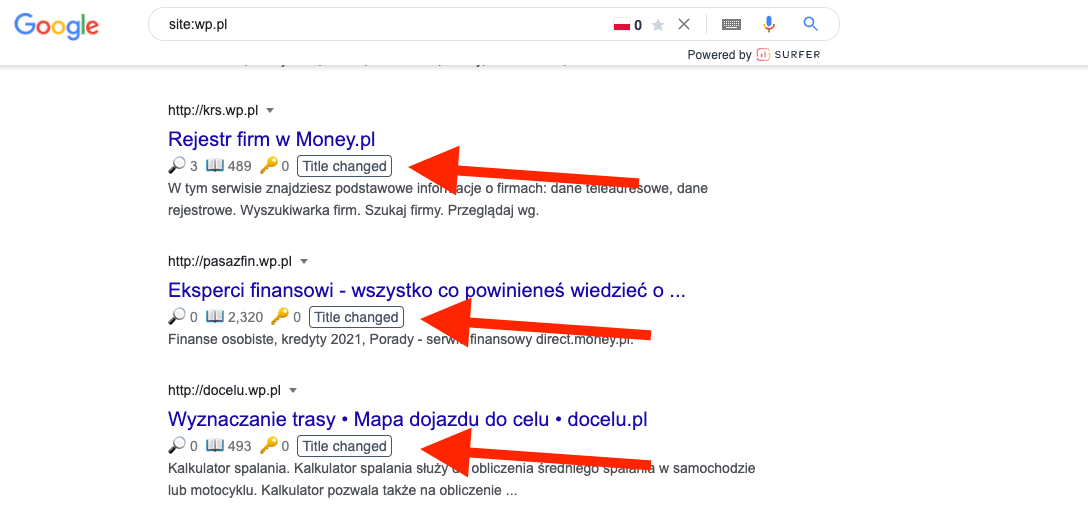 .
.
Having this plugin, you can use site operator:yourdomain and check manually how many titles have been changed.
After such analysis, all that’s left for you to do is prepare meta titles that Google will like.
How to write a good meta title?
.
The recipe is quite simple and worth writing down or memorizing:
- Start with the most important keyword
- If you can, use a CTA – a call to action; a keyword that will encourage people to click on your link
- Check the length of your meta title
- If the length allows you to include your company/brand name – do so, however, with a “-” or “|” separator.
.
.
.
And now it’s time for the promised pixel trick – remember?
How to turn up the meta title?
.
If the meta title is supposed to be 600px, and the dots take up 20px, then we have 580px available.
Now, if we write the meta title according to the previous 4 points, but fit in these 580px, we will be able to add a long tail phrase to the meta title, which will no longer be displayed to users (three dots will be displayed after the brand) but it will be read by the indexing robots, which can positively affect the position of the subpage.
However, remember not to place keywords in an unnatural way.
How does the meta title affect positions and the number of hits on a page?
.
As I wrote earlier, the meta title has a very big impact on Google position. Therefore, you need to pay a lot of attention to it. It describes to the search engines what is on the sub-pages and throughout the site.
As you can see from the algorithm update, Google takes strong consideration of what is in the meta title – although possibly to a lesser extent, since it can choose a better title itself. That’s why it’s all the more important to focus on writing quality meta titles for each subpage. Not only for the sake of your site’s position, but also for the CTR for address URLs that display to the user on Google.
How to measure the effectiveness of meta titles?
.
The best way to see if meta titles work for your Google position is simply to verify it on your own domain. If you’ve never paid attention to creating them, it’s worth getting started now.
If you are optimizing your existing meta titles, I recommend testing them for a few days to see if the optimization has had the desired effect. During testing, however, it is worth paying attention to the seasonality of the main phrase.
How to check it? You definitely need to monitor the positions for your URLs. You can do this using the Positions report or the Monitoring module in Senuto.
In addition, also pay attention to the positions in Google Search Console and the CTR, or click-through rate. Why? Because your position in search results may not change, but your click-through rate may increase.
Add Google Analytics and traffic data from the site’s organic search results to have a complete picture of the effectiveness (or lack thereof) of meta title tags.
.
Now you know practically everything about meta title tags. However, it’s worth showing you what good and bad examples of meta title tag usage look like.
Bad examples
.
- Example of too long meta title:
.

- Example of not using key phrase and too long title:
.

- Example of too short meta title, without key phrase, CTA and branding:
.

Good examples
.
- Example of using the keyword at the beginning and branding:
.

- Example of using CTA in meta title:
.

- Example of the use of a keyword phrase in the first place, a CTA and at the same time a long tail phrase and the placement of branding:
.

Where and how can I add/change the meta title?
.
HTML code
.
If your site is not based on WordPress or any other popular CMS, you can change the meta title by uploading the swapped file via FTP or by adding a line of code to the head section of the landing page file via Direct Admin.
Then the page code could look like this:
<!DOCTYPE html> <html lang="en"> <head> <title>The title you want to give the page</title> </head> <body> <h1>header</h1> <p>Paragraph content</p> </body> </html>
.
WordPress
.
The matter of adding a meta title to a WordPress-based site is quite simple – it doesn’t require putting anything in the code.
When setting meta titles for a page, one of three popular SEO plugins on WordPress will be helpful: Rank Math, Yoast SEO and All in One SEO.
How to set meta title in Rank Math SEO?
.
- .
- Log into your WordPress dashboard, then go to edit the subpage of your choice – no matter if it’s a product page, a blog post or a static page.
- Go to the very bottom of the page to the Rank Math SEO section and click on the blue “Edit Extended Section” button.
- Next, in the “Title” field, enter your title.
- Now all that’s left for you to do is publish or update the subpage.
.
.
.
.
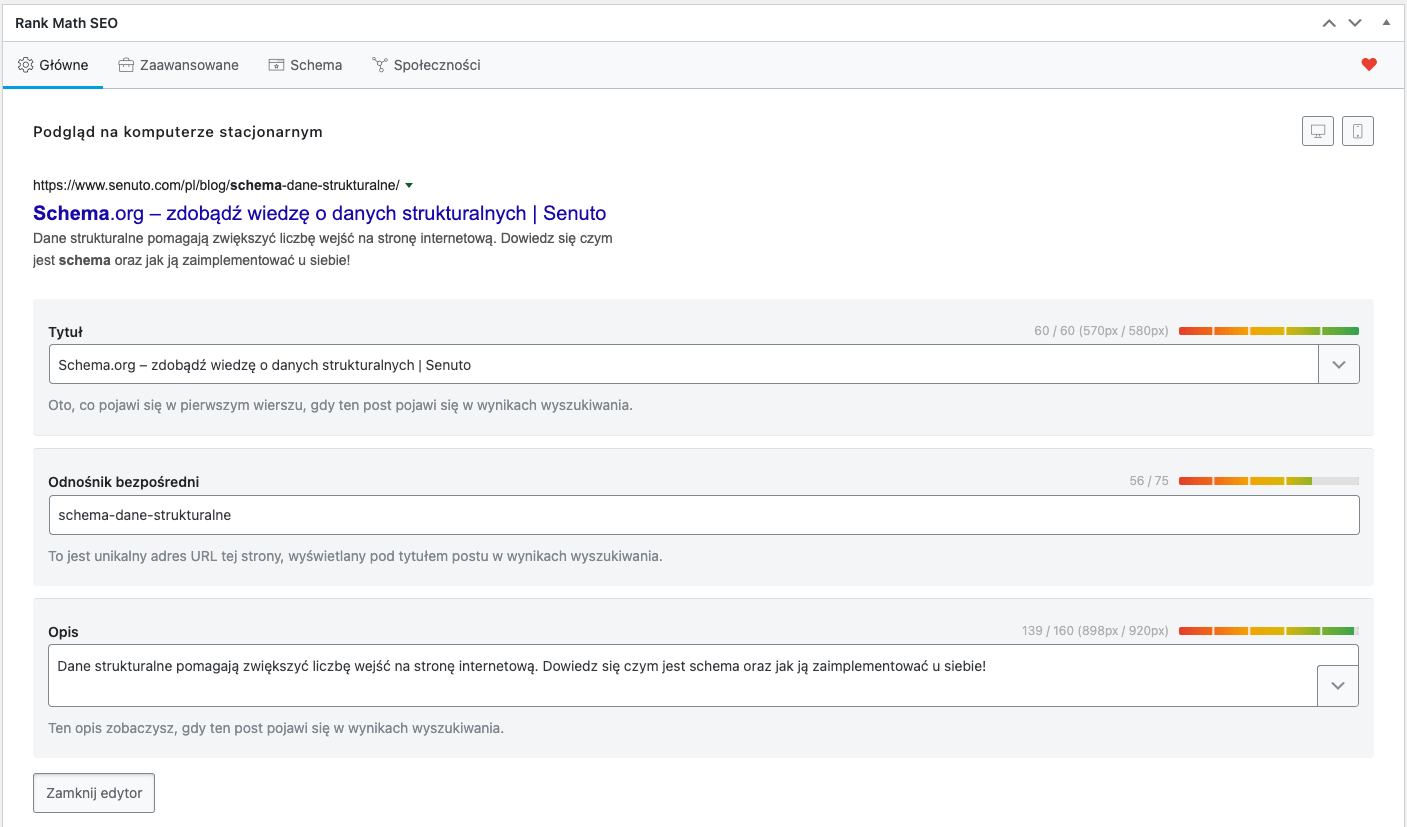
As you can see, Rank Math also has a pixel counter. This will save you some time jumping between tabs and pasting meta titles.
How to set meta title with Yoast SEO?
.
- .
- Log into your WordPress dashboard, then go to edit the desired subpage.
- Go to the bottom of the page to the Yoast SEO section.
- In the “SEO title” field, enter your title. You can preview the meta title in mobile and desktop results.
- Click “Publish” or “Update” the sub-page you are on.
.
.
.
.
Setting up a page’s meta title with Yoast SEO is also easy. Here you will also find information about the length of the meta title, but on the plus side compared to Rank Math SEO is the presentation of mobile results.
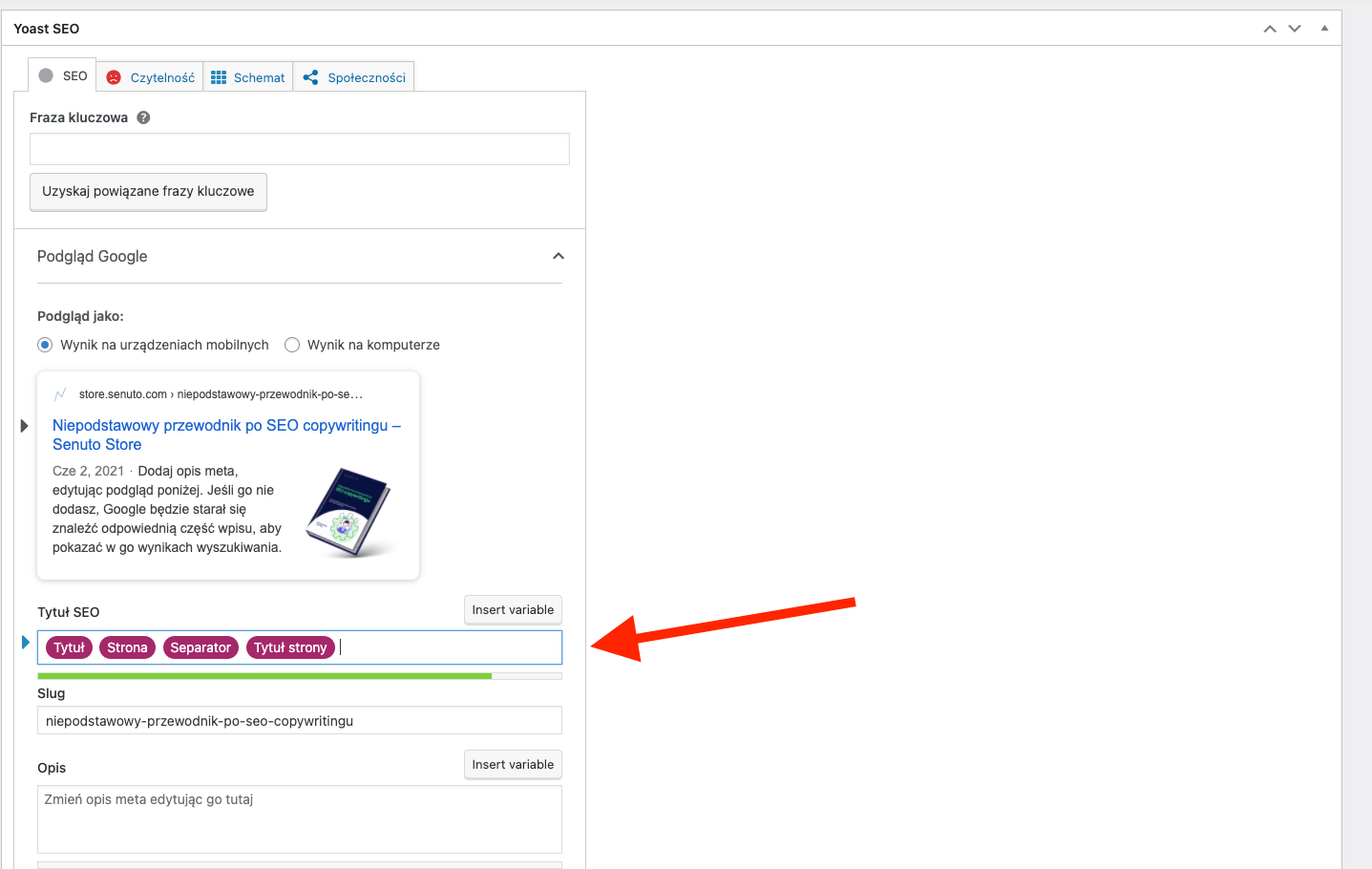
Setting meta title in All in One SEO
.
- .
- Log into the WordPress dashboard.
- Pass to edit the selected sub-page.
- Pass to the bottom of the page.
- Go to the bottom of the All in One SEO section.
- In the “Title” field, enter the prepared meta title.
- Click “Publish” or “Update” the edited subpage.
.
.
.
.
The operation of this plugin is no different from the previous ones. Everywhere, changing the meta title is limited to 5 steps. What works to the disadvantage of this plugin is that it counts the characters, not the width that the meta title occupies.
Full instructions can be found here: https://aioseo.com/docs/setting-the-seo-title-and-description-for-your-content/.
 Jakub Trybuła
Jakub Trybuła